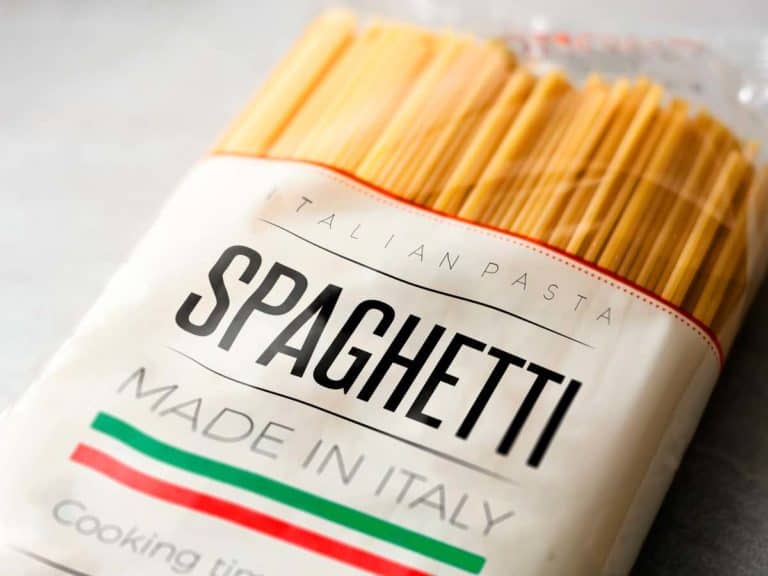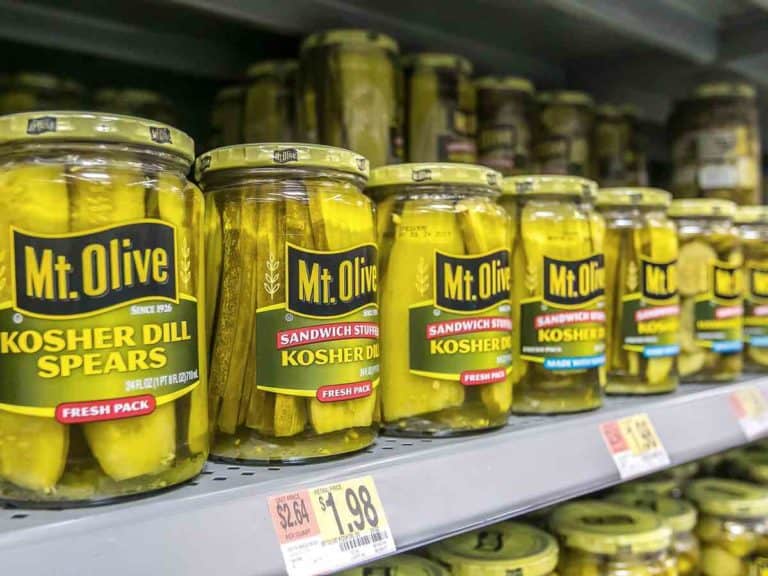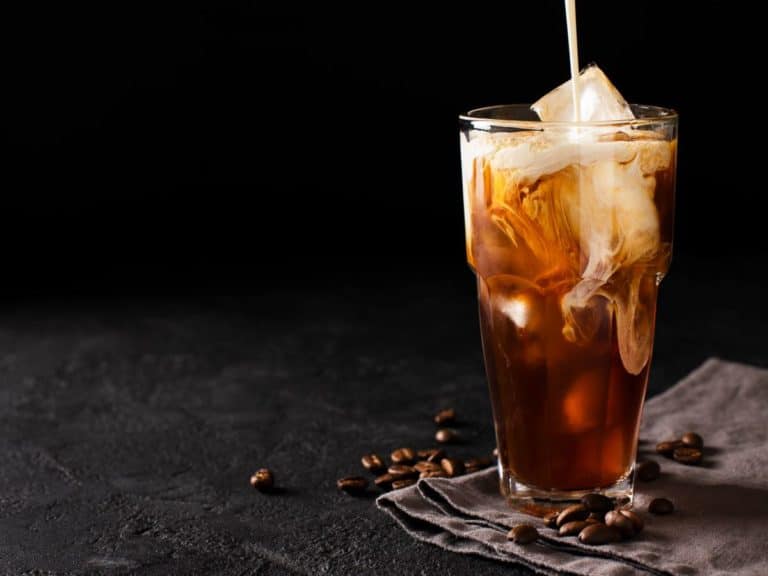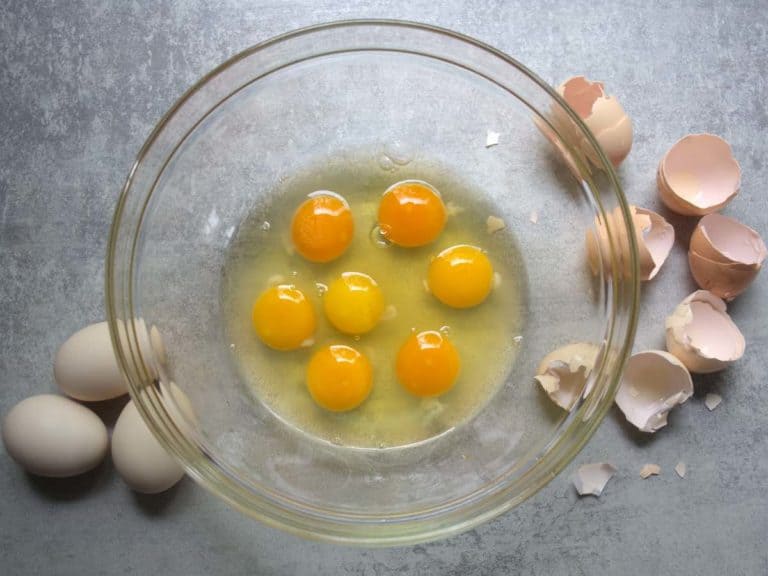Chines Noodle Dishes Explained: Chow Mein vs Lo Mein vs Ho Fun vs Mei Fun vs Mein Foon vs Mai Fun vs Chow Fun vs Singapore Chow Fun
A quick scan of the menu at a Chinese restaurant will reveal the fact that there are lots of noodle dishes with “fun” and “chow” in their names, which is no fun if you are ready to chow!
Fortunately, this post will keep your brain (which, coincidentally, is also sometimes referred to as the noodle) from aching each time you are in the mood for some noodles — I will talk about some of the most popular ones so that you can do away with all the confusion and get to the exhilaration of your senses without any delay.
How to Tell Different Noodle Dishes Apart
It can be very easy for an assortment of Chinese noodle dishes, the vast majority of which are mixed with vegetables and meat or seafood, to be mixed up.
This is especially true for anyone who hasn’t been ordering them for a while now or someone who has been enjoying them for some time now but whose memory is just downright poor and unreliable.

Other than memorizing the things I mentioned about each above, you may also be able to easily tell them apart by observing their appearance very closely, which is of course only possible if the menu came with photos of all available noodle dishes.
But let me make it easier to tell them apart by quickly comparing them with each other.
Below, you will come across a table that evaluates various noodles using some comparative factors: the types and textures of the noodles and the amount and flavor of the sauce added.
By mastering the following, you will feel more confident and like an authority on delicious noodle dishes the next time you dine-in or order take-out:
| Noodle Dish | Noodle Type | Noodle Texture | Sauce Amount | Sauce Flavor |
|---|---|---|---|---|
| Chow mein | Egg noodles | Crunchy | Very little | Sweet |
| Lo mein | Egg noodles | Soft | Generous | Sweet |
| Ho fun | Flat rice noodles | Chewy | Very little | Savory |
| Mei fun | Rice vermicelli | Soft | Very little | Spicy |
| Mein foon | Rice vermicelli | Soft | Just right | Sweet |
| Mai fun | Rice vermicelli | Soft | Very little | Spicy |
| Chow fun | Flat rice noodles | Chewy | Very little | Sweet |
| Singapore chow fun | Rice vermicelli | Crunchy | Very little | Spicy |
The noodles used and the sauce added are some of the things that define each noodle dish.
On the other hand, the rest of the ingredients added — from the kinds of vegetables used, types of protein added to the spices used to enhance the flavor — can vary.
Especially if a particular noodle dish is loved in various parts of the planet, you can be certain that the recipes for it can differ from one another either slightly or wildly.
Finding a recipe that suits your personal taste and preference, of course, is the way to go.
And if you want to enjoy the noodle dish as it’s meant to be enjoyed, then it’s a traditional recipe you should stick to.
Chow mein
“Stir-fried noodles” or “fried noodles” — that’s what the Chinese term “chow mein” means in English.
Traditionally, chow mein is a simple noodle dish consisting of nothing but stir-fried noodles with chopped vegetables. There are instances, too, when meat or tofu is added to the mix.
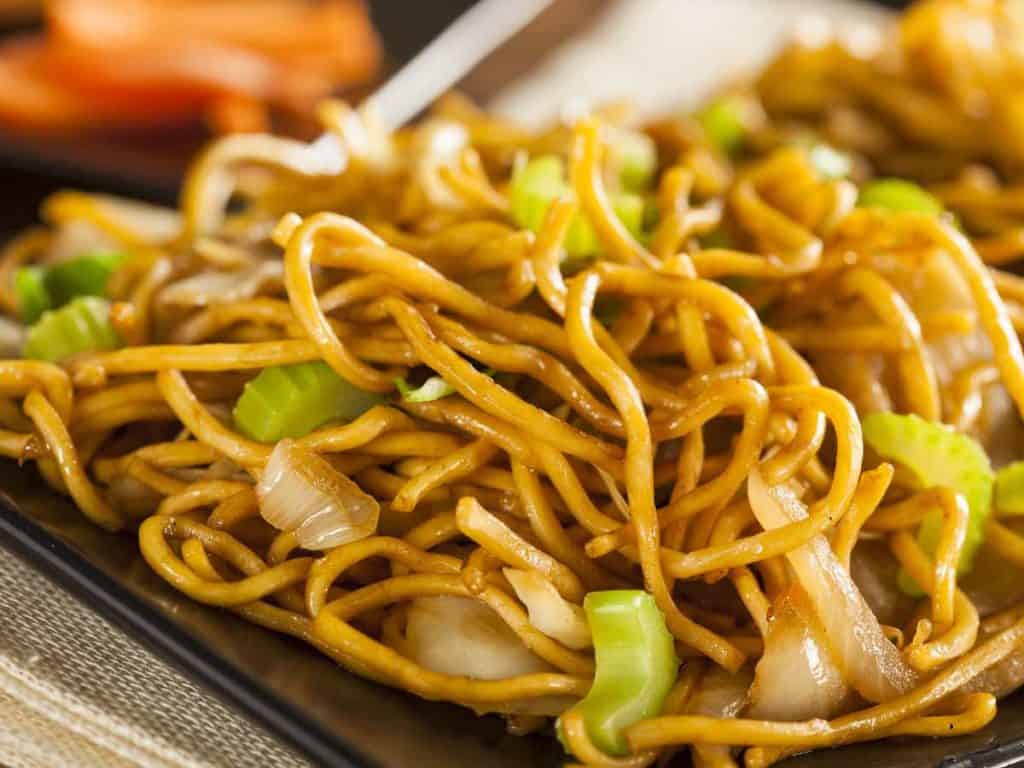
Over the centuries, however, different variations of chow mein appeared in various regions of China, which means that the noodles were fried in an assortment of ways and all kinds of toppings were used.
Eventually, Chinese immigrants introduced the many forms of chow mein to other countries, from India to Nepal and from the US to the UK.
A notable characteristic of chow mein is that it’s on the dry side of noodle dishes.
The sauce is extremely light and delicate, often made with cornstarch, ginger, brown sugar, sesame oil, soy sauce and oyster sauce. Depending on the recipe and iteration, a little chicken or vegetable broth is sometimes added.
In American Chinese cuisine, it’s not uncommon for chow mein to consist of a lot of meat. While chicken is the most common pick, beef, pork and even shrimp are also used.
Chow mein is sometimes steamed, too, which gives the noodles a softer texture — traditional chow mein has slightly crunchy noodles given the fact that they’re stir-fried and with very little sauce.
And speaking of which, Chinese egg noodles are the ones used for making chow mein.
Chinese egg noodles can come fresh or dried. But either of them can be used for whipping up chow mein. No matter the noodle type of choice, the fact remains that Chinese egg noodles need to be softened in boiling water beforehand.
Lo mein
Simply put, the Chinese term “lo mein” means “stirred noodles” or “tossed noodles” in English. And now that we’ve made its literal meaning clear, there’s no need to toss and turn in bed wondering what the Chinese noodle means.
But there are many other things to know about this popular noodle dish.
In the US, for instance, not a lot of people can tell apart lo mein and chow mein, which we just finished talking about.
A way to determine whether or not what’s in front of you is lo mein is by checking out the amount of sauce — lo mein is generously covered in sauce, which is made of ginger, sugar, sesame oil, oyster sauce and dark and light soy sauce.
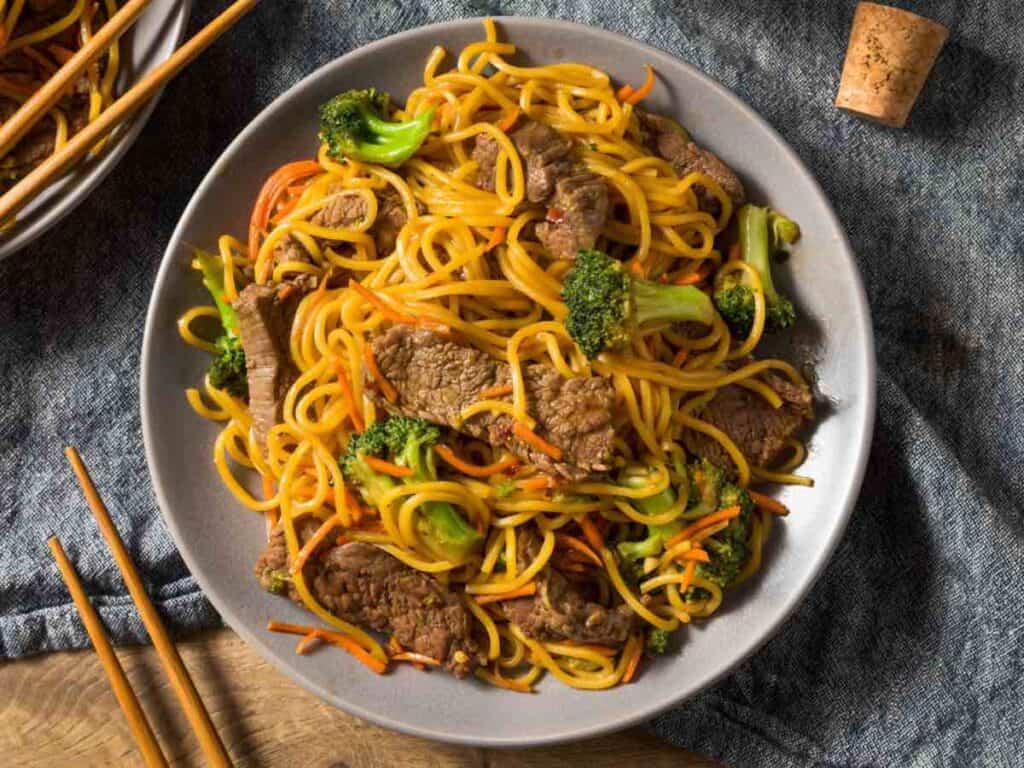
Other than the sauce, the accompanying ingredients also come in generous amounts. Traditional lo mein contains lots of vegetables and optional protein such as chicken, beef, pork and shrimp. In some instances, it’s also served with wontons.
Chinese egg noodles are customarily used for making lo mein.
Fresh Chinese egg noodles are usually preferred over the dried variety. In the US and elsewhere on the planet, other types of noodles are also used, including rice noodles, ramen noodles and even spaghetti.
Unlike some other Chinese noodle dishes, the noodles and the rest of the ingredients are cooked separately — fresh Chinese egg noodles are boiled in a pot, while the vegetables and protein are stir-fried in a wok and then cooked in lavish amounts of sauce.
Afterward, the noodles are tossed into it — hence, the delicious dish literally means “tossed noodles”.
Ho fun
The Chinese noodle dish called “ho fun” is named after the type of rice noodles used in making it — they are wide and flat and usually measure anywhere from 3/4 to 1 inch in thickness.
Before anything else, let’s get one thing straight: ho fun and ho fan are one and the same.
Ho fun, the noodles, are first boiled or soaked in water if the dried kind is used.
Afterward, they are stir-fried in vegetables and, depending on the recipe or the preference of the one cooking it, some protein like chicken, pork or beef. Vegetarians usually replace protein with either mushrooms or tofu or both.
The various ingredients are cooked in a small amount of sauce, which is usually made with soy sauce and oyster sauce. The recipe won’t be complete without the addition of a little sesame oil.
What makes ho fun a complete standout Chinese noodle dish is, of course, the unique noodles used.
Chewy and satisfying — that’s how ho fun is usually best described. Because they are wide, there’s plenty of room for the flavor of the sauce and the other ingredients to get into.
And since ho fun tends to break apart easily during cooking, eating ho fun, the delicious dish, is like eating short noodles.
Mei fun
There’s a type of Chinese noodles referred to as “mei fun”. In the English-speaking world, it’s known as dried rice noodles — or what you will come across at the supermarket as “rice vermicelli noodles”.

Something that makes mei fun a fun noodle dish to eat for many is that it contains lots of spices.
In most instances, curry powder is added to it.
There are times, too, when what’s used instead is 5-spice powder, which consists of cloves, star anise, fennel seeds and Chinese cinnamon.
Ground white pepper and garlic powder are also staple ingredients in many recipes, with some calling for the addition of sriracha.
Like many Chinese noodles, mei fun has veggies in it. Some of the most commonly used ones are bamboo shoots, bean sprouts, cabbage, carrots, celery and scallions.
Of course, proteins such as chicken, pork and shrimp are usual additions to the mix, too.
There’s an ingredient that, without it, won’t make mei fun complete: scrambled eggs!
In a recipe that serves 2 people, scrambling 2 large eggs is usually called for, which is cooked separately and then broken apart and then gently tossed into the rice vermicelli noodles and the rest of the ingredients about 30 seconds before the dish is served.
Barely noticeable is the sauce, which is made of oyster sauce, fish sauce, sesame oil and a little Shaoxing wine or cooking wine, which is also often used as an ingredient for the marinade for the protein component to make it not only tender but also more flavorful.
A small amount of cornstarch is used, too, in order to thicken the sauce.
Mein foon
When people say “mein foon”, they are referring to either rice noodles or a noodle dish containing rice noodles.
The literal translation of the term is “rice noodles”. Simply put, rice noodles are made from rice flour and water. They are commonly available dried, which means that they need soaking in warm water for 10 to 15 minutes before use.
It’s in the cuisines of southern China and Hong Kong where mein food is very popular. However, it’s not uncommon for the noodle dish to be also consumed often in Singapore and Malaysia.
And since it’s popular in various Asian regions, it doesn’t come as a surprise that there are many different iterations of it.
Chicken mein foon and shrimp mein foon — these are the most popular versions of it.
Other protein types such as beef and pork may be used as well. But no matter the preference, it’s always that mein foon comes with stir-fried vegetables into which softened rice noodles are tossed.
Similar to many other Chinese noodle dishes, mein foon comes with a complex-flavored sauce made of various ingredients such as ginger, garlic powder, sugar, soy sauce, oyster sauce, vegetable broth and Shaoxing wine or cooking wine.
To thicken the sauce, the amount of which should just be enough to thinly coat the rice noodles and other ingredients, cornstarch is added.
Mai fun
The name “mai fun” sounds very close to the name of a Chinese noodle dish we have already talked about: mei fun. Well, these noodle delights are referred to by similar-sounding names because they are one and the same.
Whether it’s called “mai fun” or “mei fun” is completely up to your preference.
And speaking of which, what’s so nice about mai fun is that it’s so versatile and flexible when it comes to the ingredients added to rice vermicelli noodles.
For instance, you can choose to add practically any vegetable of your liking.
So, in other words, you can make your homemade mai fun as colorful and as nutritious as you want.
However, to give the noodle dish an interesting texture, it’s a good idea to stick to veggies that are commonly stir-fried, the kinds that remain crunchy after cooking. Some popular examples are asparagus, bean sprouts, broccoli, cabbage and carrots.
Earlier while we were talking about mei fun, I mentioned that some add sriracha to the sauce to give it a kick.
What I forgot to mention is that you can also add some chili oil to the sauce of mai fun to make it more enjoyable to eat.
After all, having something hot and spicy can cause the release of endorphins, which are happy hormones. Other than lifting the mood, endorphins also help lower stress levels and decrease pain perception, too.
Chow fun
Another Chinese noodle dish we have already tackled is ho fun.
And it was also mentioned that it’s called such because of the type of noodles used in making it: ho fun. The flat and wide noodles are commonly used, too, for making chow fun.

In a nutshell, chow fun consists of ho fun that’s stir-fried with bean sprouts, although many other vegetables may be used, too. It’s also dressed in a savory brown sauce made of regular soy sauce, dark soy sauce, sesame oil and brown sugar. Serving the dish is best done with a generous amount of sauce and with some chili oil on the side.
Other than vegetables, protein is also an important ingredient in chow fun making.
Chicken and pork are popular choices. The same is true with shrimp. However, none is as well-liked (as far as chow fun is concerned) as beef. So much so that if you look for chow fun recipes online, the vast majority are beef chow fun.
For the most authentic result, sliced beef is marinated for a few minutes in a mixture of oyster sauce, soy sauce, tamari, Shaoxing wine or cooking wine, white pepper, sugar, cornstarch, baking soda and water.
Then it’s seared in a wok.
The rest of the vegetable and sauce ingredients are stirred in until cooked, which is then followed by the last step: stirring in of ho fun.
When cooking chow fun, there’s one very important thing to remember: wok hei.
Translated to English, it means “the breath of the wok”. It is achieved by cooking chow fun (or any other stir-fried Chinese gems) quickly over high heat, which results in an unmistakable umami flavor.
Singapore chow fun
First things first: Singapore chow fun, despite what it’s called, did not originate in Singapore. As a matter of fact, this rice vermicelli noodle dish that’s seasoned with curry powder did not come into being anywhere in Southeast Asia.
Hong Kong — it’s believed to be the rightful birthplace of Singapore chow fun.
What’s really nice about Singapore chow fun is that making it is simple and easy.
So much so that, back in the 1960s, it was very popular among the working class who are looking for a cheap, delicious and carbohydrate-packed meal that they can enjoy in a flash.
After all, cooking it is basically tossing together meat, vegetables and rice noodles in a searing hot wok.
And speaking of which, the type of noodles used in Singapore chow fun making is vermicelli rice noodles, which are turned from bland to grand with a dose of curry powder.
Because of its sheer popularity, there are many different recipes for Singapore chow fun on the internet these days.
But if you want something authentic, look for something that includes eggs in the list of ingredients — the noodle dish is traditionally made with eggs, which are scrambled and broken into small pieces and added to the mix in the end.
A standout characteristic of Singapore chow fun is that its rice noodles are crunchy.
It’s exactly due to this why it’s recommended to add only a small amount of sauce, which consists of soy sauce, oyster sauce, sesame oil, sugar, lime juice and Shaoxing wine or cooking wine.
Needless to say, in order to keep the crunchiness through and through, crunchy vegetables such as mung bean sprouts, red onions and red bell peppers are added, although just about any veggies good for stir-frying can be used, too.
And, unless you are a vegetarian, the noodle dish is completed with the addition of protein, usually beef or shrimp.
Which Noodle Dish is Healthier?
The vast majority of Chinese noodle dishes have vegetables in them.
Not only do chopped vegetables, which are usually stir-fried separately or together with the noodles, add some crunch to give the dish an interesting and delightful texture but also enhance the nutritive content of every serving.
After all, veggies are packed with vitamins, minerals, antioxidants and fiber.
Proteins added to noodle dishes also add — you guessed it! — protein dish plus a bunch of essential nutrients.
Sadly, because some of the ingredients are high in calories, fat and sodium, consuming them in excessive amounts is a complete no-no. And people who are steering clear of gluten and MSG should keep their eyes peeled, too.
And now, let’s rank everything from the healthiest to the not-so-healthy based solely on the amount of sodium, calories and fat.
The methodology used?
I gave a lower score (on a 1 to 10 scale) to Chinese noodle dishes that are lower in things you don’t want — the higher the score, the worse for your well-being. The following is the resulting ranking:
| Ranking | Noodle Dish | Sodium | Calories | Fat | Average |
|---|---|---|---|---|---|
| #1 | Chow mein | 5 | 3 | 2 | 3.33 |
| #2 | Ho fun | 3 | 7 | 1 | 3.67 |
| #3 | Mai fun | 7 | 1 | 4 | 4 |
| #4 | Singapore chow fun | 1 | 5 | 7 | 4.33 |
| #5 | Chow fun | 8 | 2 | 6 | 5.33 |
| #6 | Mei fun | 9 | 5 | 5 | 6.33 |
| #7 | Mein foon | 4 | 6 | 10 | 6.67 |
| #8 | Lo mein | 4 | 8 | 9 | 7 |
Below, I will talk about each noodle dish we have talked about earlier nutrition-wise.
And what’s more, I will rank each one’s fat, calorie and sodium content (1 being optimum for the health and 10 being worst for the health) so that we can determine which noodle dishes are more suited for those who have to watch what they put in their mouths.
Chow mein
Egg noodles used in making chow mein contain around 221 calories and 3 grams of fat per cup. Refrain from assuming that egg noodles are gluten-free just because eggs have absolutely no gluten — flour is an ingredient for making egg noodles.
While not a lot of sauce goes into the making of the noodle dish, the ingredients used are still high in sodium. And that is why 1 cup of chow mein can pack as much as 474.4 mg of sodium. Of course, it can vary depending on the recipe.
Because egg noodles are high in protein, chow mein is a great high-calorie treat for bodybuilders.
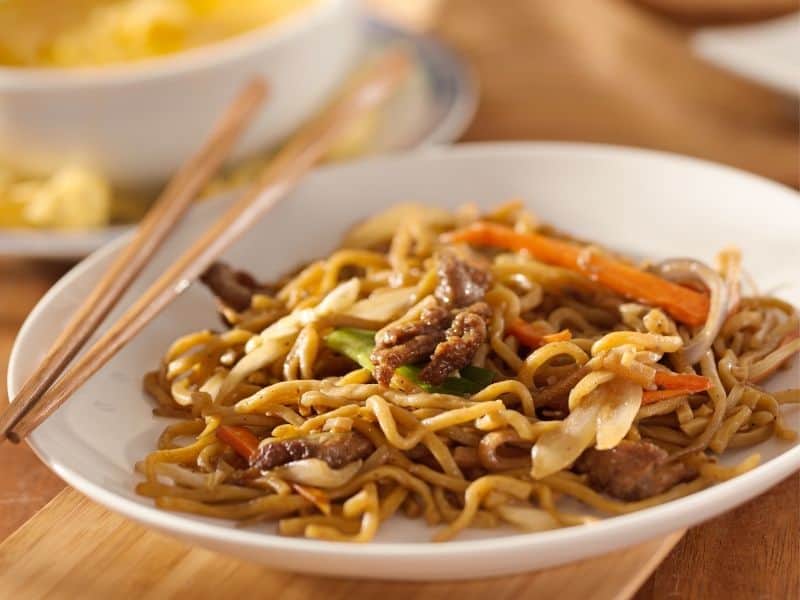
Lo mein
Just like chow mein, lo mein is made using egg noodles. But because it’s cooked differently, its noodles are more soft than crunchy. It’s also served with more sauce, which means that it has more calories and sodium per 1-cup serving.
As a matter of fact, every serving of lo mein packs around 500 mg of sodium. On the other hand, a cup of the Chinese noodle dish contains around 310 calories and 12.1 grams of fat.
Those who are keeping high blood pressure in check should avoid or limit their intake of lo mein.
Ho fun
In making ho fun, flat rice noodles are used. It’s no secret that rice is starchy, which makes it high in carbohydrates. And that is why a cup of the noodle dish packs approximately 305 calories.
Because ho fun comes with very little sauce only, each 1-cup serving of it contains only around 1.4 grams of fat and 452 mg of sodium — it may have the lowest sodium content thus far, but eating it in moderation is still a must to remember.
Needless to say, it may be added to the diet of hypertensive individuals once in a while.
Mein foon
Mein foon has something in common with mei fun: they both use rice vermicelli noodles. With all ingredients taken into account, a cup of mei foon contains about 14 grams of fat and approximately 300 calories, given that sugar is added to the sauce.
Around 500 mg of sodium is in a 1-cup serving of the Chinese noodle dish, which isn’t surprising as the ingredients used in making its sauce are on the salty side of things.
With a rather high sodium content, those who are watching their blood pressure or weight should eat it moderately.
Mai fun
Per 1 cup serving of mai fun, there are about 196 calories — it’s not that high because the sauce of this Chinese noodle dish is spicy, which means that recipes usually call for very little to no addition of sugar.
In terms of fat content, every cup of mai fun contains only around 3.4 grams of fat. On the other hand, it packs around 534.8 mg of sodium, which means that it doesn’t have the highest and lowest sodium content thus far.
Being a low-calorie and low-fat noodle dish, it’s ideal for people who wish to shrink their waistlines.
Chow fun
Because it uses flat rice noodles, it’s for certain that chow fun has more carbohydrates than usual. True enough, every cup of it has 204 calories — the only thing that keeps it from being higher is that only a small amount of sauce is present.
And speaking of which, despite the use of little sauce, the noodle dish still contains around 575 mg of sodium. That’s because many of the ingredients are salty, including tamari, which is a Japanese soy sauce. Meanwhile, a serving has 7.1 grams of fat.
Make sure that you consume chow fun in moderation if your blood pressure is not optimal.

Mei fun
Rice vermicelli noodles, as the name suggests, are made from rice, which is why it’s higher in calories than most other noodle types. As a matter of fact, a cup of it has around 190 calories, which is similar to the caloric content of 1 cup of rice.
All in all, the amount of calories in a 1-cup serving of mei fun is about 290 calories. The small amount of spicy sauce added to it brings the Chinese noodle dish’s fat content to 6.7 grams and sodium content to 578 mg per same serving size.
People with an active lifestyle could benefit from the caloric content of mei fun.
Singapore chow fun
Depending on the recipe, a 1-cup serving of Singapore chow fun can have as little as 312 mg of sodium to as many as 800 milligrams of sodium. On the other hand, it can have up to 9 grams of fat.
With a spicy sauce, the addition of sugar as an ingredient can be avoided. Still, every serving of the noodle dish has approximately 290 calories, mainly because the noodles used (rice vermicelli) are rich in carbohydrates.
Singapore chow fun, needless to say, is great for anyone who loves spicy food and an instant dose of energy.
Noodle Dish FAQs
And now, we have come to the section of this post where, hopefully, any remaining confusion you have over some of the most popular and delicious Chinese noodle dishes will be addressed.
This way, you can be certain to order the noodle dish you are craving for exactly, thus allowing you to have the most enjoyable dining experience possible.
So, without further ado, let’s get started!
Lo mein vs. chow mein vs. mei fun
Both lo mein and chow mein use egg noodles. On the other hand, mei fun uses rice vermicelli noodles. Other than the type of noodles used, these 3 noodle dishes also differ when it comes to the sauce used. While all of them have very small amounts of sauce, lo mein and chow mein have a sweet sauce, while mei fun has a spicy sauce.
Chow fun vs. mei fun
Even though chow fun and mei fun use rice noodles, they use different kinds. Chow fun uses wide and flat rice noodles, which are very good at absorbing the flavors of the sauce and the rest of the ingredients. On the other hand, mei fun uses rice vermicelli noodles, whose strands are thin and round, which is great for stir-frying to make them crunchy.
Chow mein vs. lo mein
The noodles used in making chow mein and lo mein are the same, and it’s none other than egg noodles. However, the cooking method gives their noodles a different texture — chow mein has crunchy egg noodles, while lo mein has soft egg noodles. The sauce of both are on the sweet side, but lo mein is served with a more generous amount of sauce.
Chow ho fun vs. chow mei fun
What’s common between chow ho fun and chow mei fun is that both of them use wide and flat rice noodles, which almost always guarantees a tastier Chinese noodle dish. Chow ho fun is well-liked for its sweet sauce with some spicy notes. Meanwhile, many know as well as prefer chow mei fun as a noodle dish with a spicy sauce.
Ho fun vs. chow fun
Not a lot of people find it easy to tell ho fun and chow fun apart. A reason for such is that both of them use wide and flat noodles. Besides being the same, the noodles used are cooked in a way to give them a chewy texture. But it’s the sauce that sets them apart — the sauce of ho fun has a savory flavor, while the sauce of chow fun has a sweet taste.
Singapore chow fun vs. mei fun
There are many things shared by Singapore chow fun and mei fun in common. For one, they both use rice vermicelli noodles, although the noodles of Singapore chow fun have a crunchy texture as a result of stir-frying them. The sauces they have are both spicy, but it’s something that you shouldn’t worry about as Singapore chow fun and mei fun have little sauce.
Mei fun vs. lo mein
The similarities between mei fun and lo mein end with the fact that they are both Chinese noodles. In terms of the noodles used, mei fun uses rice vermicelli noodles, while lo mein uses egg noodles — these noodles have different appearances and textures. The sauce of mei fun is spicy, while the sauce of lo mein is sweet, not to mention that there’s lots of it, too.
Chow mein vs. chow fun
One look and it’s easy to tell chow mein and chow fun apart — the former uses egg noodles, while the latter uses wide and flat rice noodles. But there are a couple of things that these noodle dishes have in common. For instance, they are cooked with only a little amount of sauce. In addition, they both have sweet-tasting sauces.
Chow fun vs. chow mein
Both chow fun and chow mein have sweet sauces alright. What’s more, you will not see a lot of them — just enough sauce is usually added to cover the noodles. And speaking of which, these Chinese noodle dishes use different types of noodles. Chow fun uses wide and flat noodles with a chewy texture, while chow mein uses egg noodles with a crunchy texture.
Read Next: Difference Between Pasta And Noodles
